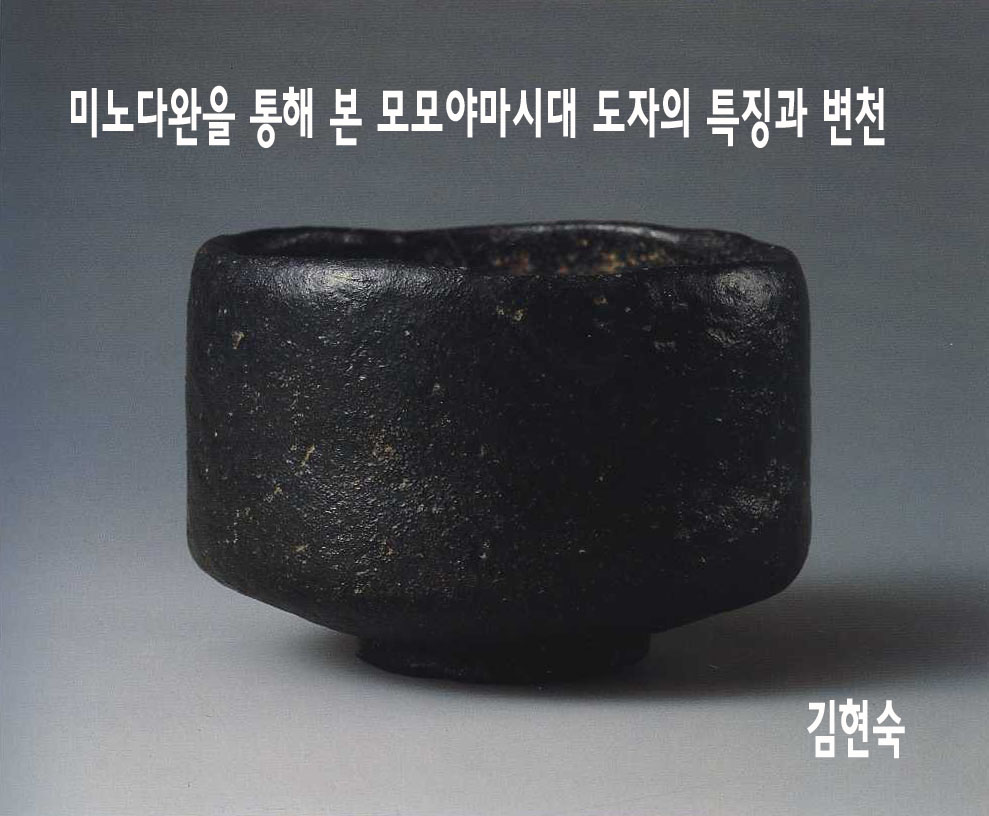
미노 다완(美濃茶碗)을 통해 본 모모야마시대(桃山時代) 도자의 특징과 변천
= The Characteristics and Changes of Ceramics in the Momoyama Period through Mino Teabowl
홍익대학교 도예유리학과
겸임교수 김현숙
국문 초록
중국의 차 문화와 차 도구가 일본으로 유입된 무로마치시대 말기 이후, 문화적 융성기였던 모모야마시대에 토키시를 중심으로 다양한 다완이 생산되었다. 그 중 천목 다완은 일본 다도문화의 시발점으로 평가받는다. 다도인 센노리큐는 도예가 쵸지로에게 의뢰해 제작된 쿠로라쿠 다완으로 일본 특유의 와비‧사비 미학을 정립시켰으며, 쵸지로는 후일 세계적으로 보편화되는 라쿠 소성방법을 처음으로 소개했다.
이 시기에 제작된 다완의 외형적‧장식적 특징은 다음과 같다. 먼저 외형적으로는 원통형과 반통형이 주로 제작되었는데, 굽의 폭은 기물의 크기에 비해 좁았고, 굽의 높이는 차츰 낮아졌다. 기물의 구연부 역시 하부 둘레보다 넓은 개방형에서 하부 둘레와 비슷한 크기로 변화해갔다. 외형이굵고 불규칙하게 뒤틀린 다완도 제작되었는데, 다도인 후루타 오리베의 이름을 따서 ‘오리베 다완’이라는 명칭이 붙었다.
장식적으로는, 초기에 보이지 않았던 문양이나 그림이 등장했다. 시노 유약이 처음으로 사용되었는데, 색상과 특징에 따라 베니시노, 네즈미시노, 아까시노와 같은 다양한 유약이 제작되었다. 모모야마시대에는 중국의 녹색을 차용한 오리베 다완이 처음으로 제작되기도 했는데, 문양은 포도, 식물, 기하학적 무늬 등 당시 유행하던 물건이나 기모노 문양의 영향을 받았다.
본 연구는 일본의 다도 문화와 다완의 시발점, 그리고 모모야마라는 제한된 시대와 그 시기에 제작된 다완의 특징 및 변화를 중심으로 분석, 서술하였다. 조선에서 제작된 다완(일본명 ‘고미지마 다완’)의 독특한 형태가 미노 다완의 시초인 키세토 다완의 형태에 영향을 끼쳤다는 점은 학문적으로도 의의가 있다. 본 연구를 통해 차 도구로써의 다완은 형태와 색상 면에서 다양하게 제작되었고, 미학적 의미도 함께 담아내고 있다는 사실을 알 수 있었다. 이는 새로운 문물이 일본으로 유입되면서 사회적, 경제적 변화에 휩싸인 ‘모모야마시대’ 문화의 특징적 요소라 할 수 있다.
영문 초록
Since the end of the Muromachi period when Chinese tea culture and tea tools have flowed into Japan, various teabowls have been produced mainly in Toki City during the Momoyama period, which was a cul...
[더보기]
Since the end of the Muromachi period when Chinese tea culture and tea tools have flowed into Japan, various teabowls have been produced mainly in Toki City during the Momoyama period, which was a cultural prosperity period. Among them, Tenmoku Teabowl is regarded as the starting point of Japanese tea ceremony culture. A tea person named Sen no Rikyu established the unique Wabi and Sabi aesthetics of Japan with Kuroraku Teabowl, which was commissioned by the pottery artist named Chojiro, and Chojiro introduced the first method of Raku Firing which is universalized worldwide in the future.
The external and decorative features of teabowl produced at this period are as follows. For the shape, the main shapes were cylindrical type and half-cylindrical type, and the width of the foot was narrower than the size of the object, and the height of the foot gradually decreased. The rim of the object has also changed from open style , which is wider than the lower circumference, to a size similar to the lower circumference. Large, irregularly twisted teabowls were also made, they were named ‘Oribe Teabowl’ after the producer Huruta Oribe.
For the decoration, there were patterns and pictures that were not seen in the early days. Shino Glaze was first used, and various glazes such as Beni Shino Glaze, Nezumi Shino Glaze and Aka Shino Glaze were produced according to color and characteristics. Oribe Teabowl, which borrowed China s green, was first produced in the Momoyama period. The pattern of Oribe Teabowl was influenced by objects and kimono patterns that were popular at that time, such as grapes, plants, and geometrical patterns.
This study analyzed and described the origin of Japanese tea ceremony culture and teabowls and the characteristics and changes of teabowls made during the limited period of Momoyama. It is also academically significant that the unique form of the Japanese name ‘Gomijima teabowl’ produced in Joseon influenced the form of ‘Kisseto teabowl’, the beginning of ‘Mino teabowl’. Through this study, we can see that teabowls as a tea tool were made in various forms and colors, and also contained aesthetic meanings. This is a characteristic element of the Momoyama era , in which new cultures are introduced into Japan and are surrounded by social and economic changes.
목차
Ⅰ. 서 론
1. 연구의 목적
2. 연구의 범위와 방법
Ⅱ. 미노모모야마 도자의 발생
1. 시대적 배경
2. 다도의 미의식과 차 도구와의 관계
Ⅲ. 미노모모야마 다완의 특징과 변천
1. 형태적 측면
2. 장식적 측면
3. 오리베 다완의 변화와 특징
Ⅳ. 결론